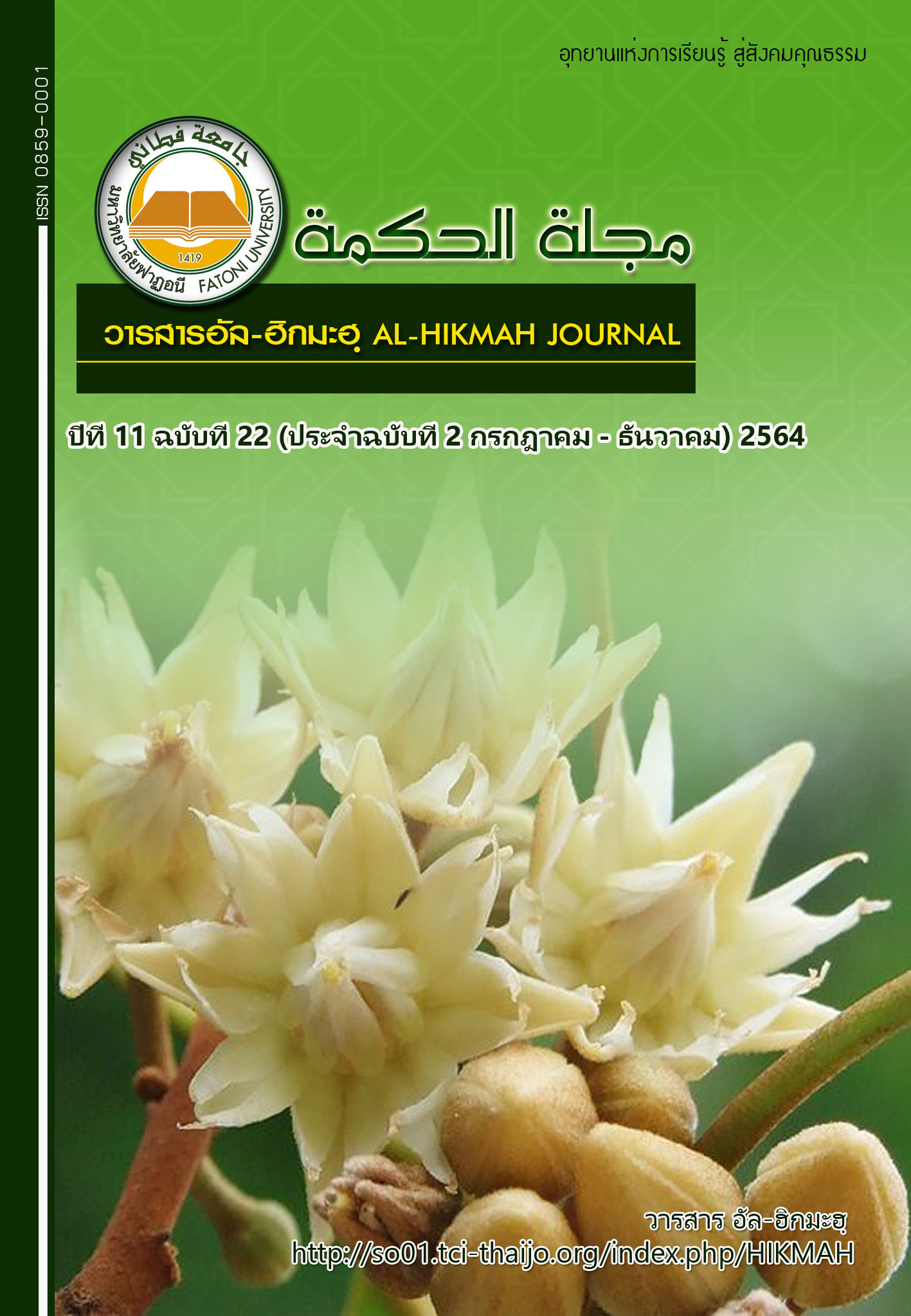Factors Associated with Social C ปัจจัยการกลั่นแกล้งบนสังคมออนไลน์ของเยาวชนสามจังหวัดชายแดนภาคใต้
Abstract
This research was a quantitative research which is aimed to study the frequency of social cyberbullying in several formats and to study the factors associated with the social cyberbullying. The population and sample size of this study was 240 persons of youths who lived in the three southernmost provinces of Thailand. Quota sampling was applied to select the sample size and questionnaire was used as a research tool. Descriptive analysis is applied to explore the frequency and percentage. Correlation and univariate analysis were tested by the Pearson chi-squared test. Separated dichotomous outcomes of logistic regression were modelled: youth who bullied other, youths who had been bullied by other, and both of youths who bullied other and had been bullied by other. The result found that 174 persons of youth (72.50%) bullied others, 122 persons of youth (50.83%) had been bullied by other, and 77 persons of youth (32.08%) had bullied other and had been bullied by other. Three models shared the common factor of causing to occur the cyberbullying was a factor of “forgetting to resign the social media after signing-on in the public computer”.
References
พิมพวัลย์ บุญมงคล, ราชาวดี เอี่ยมศิลป์, สร้อยฟ้า โต๊ะพันธ์อนนัต์, Timo Ojanen, รณภูมิ สามัคคีคารมย์, รูไวดี สาเมาะ, มุจลินท์ ชลรัตน์, Thomas Guadamuz, และอนุสรณ์ พยัคฆาคม. 2555. เพศสภาวะ เพศวิถี และการรังแกในพื้นที่ไซเบอร์ของวัยรุ่นหญิงไทย. บทความนำเสนอในงานประชุมวิชาการสังคมศาสตร์สุขภาพ ปี 2555. มหาวิทยาลัยมหิดล. โรงแรมรอยัลริเวอร์ กรุงเทพมหานคร.
วิทยา ดำรงเกียรติศักดิ์. 2558. การข่มเหง/กักขฬะออนไลน์ 2. จากอินเตอร์เน็ต. http://www.infocommmju.com/icarticle/images/stories/icarticles/ajwittaya/digital/cyberbullying2.pdf (ค้นเมื่อ 25 กรกฎาคม 2562).
วิมลทิพย์ มุสิกพันธ์, ศิวพร ปกป้อง, นันทนัช สงศิริ และปองกมล สุรัตน์. 2552. พฤติกรรมการข่มเหงรังแกผ่านโลก ไซเบอร์ของเยาวชนไทยในเขตกรุงเทพมหานคร. สมาพันธ์การวิจัยความเห็นสาธารณะแห่งประเทศไทย.
ศิวพร ปกป้อง และวิมลทิพย์ มุสิกพันธ์. 2553. ปัจจัยที่มีผลต่อทัศนคติและพฤติกรรมการกระทำความรุนแรงทั้งทางกายภาพและการข่มเหงรังแกผ่านโลกไซเบอร์ของเยาวชนไทย. มหาวิทยาลัยมหิดล กรุงเทพมหานคร.
สำนักยุทธศาสตร์ สำนักพัฒนาธุรกรรมทางอิเล็กทรอนิกส์ (องค์การมหาชน). 2562. รายงานผลการสำรวจพฤติกรรมผู้ใช้อินเทอร์เน็ตในประเทศไทย ปี 2561 Thailand Internet User Profile 2018.
Akbar, J., Huang, T. W., & Anwar, F. 2014. The development of cyberbullying scale to investigate bullies among adolescents. Proceeding of International Conference on Human-ities Sciences and Education (ICHE), Kuala Lumpur.
Bentley, T., Catley, B., Cooper-Thomas, H., Gardner, D., O'Driscoll, M., & Trenberth, L. 2009. Understanding Stress and Bullying in New Zealand Workplaces Final report to OH&S Steering.
Donner, J. 2010. Research approaches to mobile use in the developing world: A review of the literature. The Information Society, 24 (3), 140-159.
Fowler, D. (2016, August). Back to school-let’s keep our kids safe online. [online] from https://www.act-on.com/blog/back-to-school-lets-keep-our-kids-safe-online (Retrieved on April 1, 2019)
Hinduja, S. and Patchin, J. W. 2008. Cyber-bullying: An exploratory analysis of factors related to offending and victimization. Deviant Behavior, 29(2), pp. 129-156.
Kirschner, Paul & Karpinski, Aryn. 2010. Facebook (R) and academic performance. Computers in Human Behavior. 26. pp. 1237-1245.
Kokkinos, C. M., Baltzidis, E. & Xynogala, D. 2016. Prevalence and personality correlates of Facebook bullying among university undergraduates. Computers in Human Behavior, 55, pp. 840-850.
Nocentini, A., Calmaestra, J., Schultze-Krumbholz, A., Scheithauer, H., Ortega, R. & Menesini, E. 2010. Cyber-bullying: Labels, behaviors and definition in three European countries. Journal of Psychologists and Counsellors in Schools, 20(2), pp. 129-142.
Saunders, M., Lewis, P. & Thornhill, A. 2012. “Research Methods for Business Students” 6th edition, Pearson Education Limited.
Shariff, S. 2008. Cyber-Bullying: Issues and solutions for the school, the classroom and the home. 14 March 2008.
Sittichai, R. and Smith, P. K. 2018. Bullying and Cyber-bullying in Thailand: Coping strategies and relation to age, gender, religion and victim status. Journal of New Approaches in Educational Research, 7(1) pp. 24-30.
Slonje, R., Smith, P. K., & Frisen, A. 2013. Processes of cyberbullying, and feelings of remorse by bullies: A pilot study. European Journal of Developmental Psychology, 9, 244–259.
Smith, P. K., Mahdavi, J., Carvalho, M., Fisher, S., Russell, S. and Tippett, N. 2008. Cyber-bullying: Its nature and impact in secondary school pupils. Journal of Child Psychology and Psychiatry, 49(4), 376-385.
Tudkuea, T. and Laeheem, K. 2014. Development of indicators of Cyberbullying among youths in Songkhla Province. Asian Social Science. 10(14), 74-79.
Willard, N. 2005. Cyberbullying and cyberthreats. 2005 OSDFS National Conference. US Department of Education, Washington, USA. August 15, 2005, pp. 1-3.



